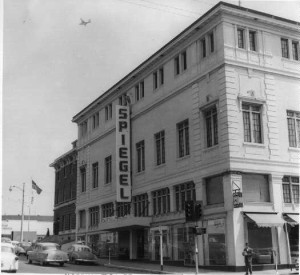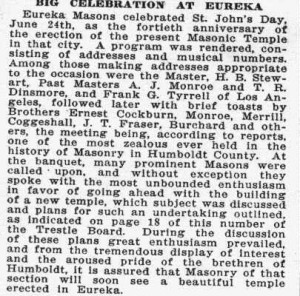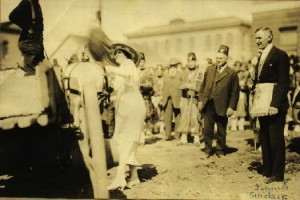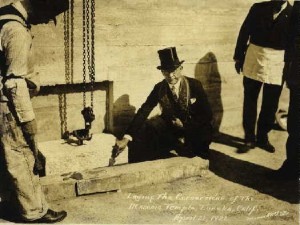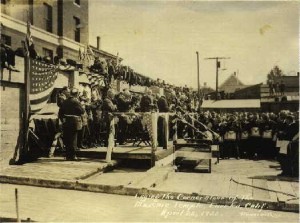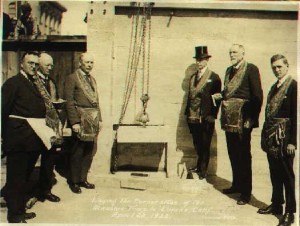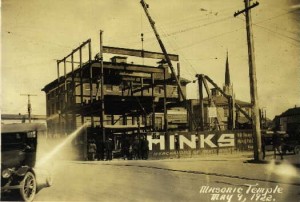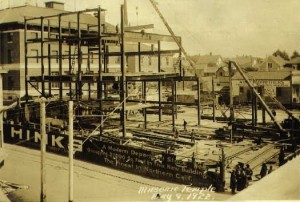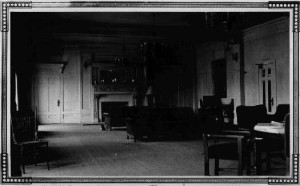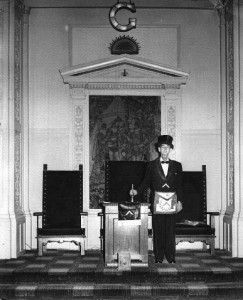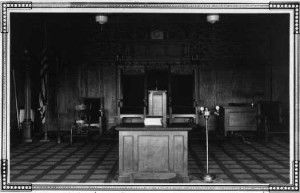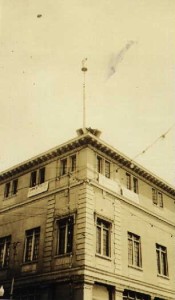One of Eureka’s largest and most impressive buildings is the Humboldt Masonic Temple which has been in use at the southeast corner of Fifth and G Streets for over seventy years. The ground breaking took place in 1921, the cornerstone was laid in 1922, and the building was first occupied by the Masons in 1923.
Membership in Humboldt Lodge grew from 13 in 1855, to 53 in 1871, to 323 in 1910. That year the lodge began to look for sites for a new building large enough to accommodate the members, as well as the Eastern Star, York Rite, Scottish Rite and other groups using the building.
Several sites on Fifth Street were looked at and options taken on lots at Fifth and E, Fifth and I, and the northeast corner of Fifth and G Streets.
A six-story building was considered for the 80′ by 110′ lot at Fifth an G Streets. The bottom two floors would be rented out for retail stores, the lodge would use the middle two floors, and the top two floors would be rented to professionals such as doctors, dentists and lawyers.
Total cost of the building was estimated to be about $200,000. The lodge had property it could sell for $50,000, and it was estimated that rents for the proposed building might bring in $16,000 a year. After much consideration the lodge deferred building a new temple.
In 1914, another lodge committee, headed by Trustom Ring Dinsmore (1878-1966), Master of the lodge in 1907, and longtime cashier of the Bank of Eureka, looked again at possible sites for a lodge temple. Most of the sites were on Sixth Street, with one as far south as Ninth Street. The committee recommended against a new downtown building (meaning north of Sixth Street) and again plans were deferred.
Frederick William Merryless Georgeson (1859-1939) had been a banker, he served as Mayor of Eureka, he was publisher of the Humboldt Standard newspaper, he had been a member of Humboldt Lodge since 1906, and had served as chairman of the 1910 committee seeking a building site.
In 1921, Georgeson took the lead in getting a new building for Humboldt Lodge. He found a good site, he lined up a retail tenant, and the issue was brought up at the March 3, 1921 meeting of the lodge. As a result a special meeting of the lodge was called for March 19, 1921, to consider the new proposal.
At the March 29th meeting everything about the building was quickly decided upon, including the financing. J.F. Hink & Son Company, Eureka’s leading store, agreed to rent 30,000 square feet of retail space for ten years for a total of $150,000 (see accompanying article). The lodge was to raise $200,000 more by selling twenty-year notes paying 3% at maturity to members of the “Masonic Family”.
June 29, 1921, the sum of $125,000 had been subscribed by the “Masonic Family” and Humboldt Lodge decided to forge ahead with the building. Eventually $300,000 was raised with notes of $100 to $5,000 and a $70,000 loan from George Washington Hunter (1853-1925).
Hunter had been a pioneer in the county as a boy, and he served as Superior Court Judge for twenty years before resigning in 1910 to run unsuccessfully for Congress. He had been a member of Humboldt Lodge since 1895, served as Master of the Lodge in 1898, and was Grand Master of Masons in California in 1904.
On July 18, 1921, Sarah J. Vance (widow of John MacGregor Vance, a nephew of John Vance), together with her children Etta L. Vance, Harry P. and Evelyn C. Vance, and Carlotta Vance Parker sold to Humboldt Lodge two lots totaling 100′ by 110′ at the southeast corner of Fifth and G Streets for the sum of $45,000.
The builder, engineer, and architect selected for the Masonic Temple were all members of Humboldt Lodge No. 79.
Franklin Thompson Georgeson (1889-1953) was the architect of the work. The then 32-year old Georgeson had already designed the Millay House at 2424 J Street, the Christian Science Church, the Richard Sweasey Theater (renamed the State Theater by Leow’s, Inc.) in Eureka, and the Minor Theater in Arcata. He also designed the Eureka Municipal Auditorium and the First Christian Church. He was the son of F.W.M. Georgeson, leader of the drive for the new building, and had himself belonged to Humboldt Lodge since 1919.
Civil Engineer for the massive structure was Clarence Edward Tabor (1888-1969), a member of the lodge since 1918.
Builder of the temple was Mercer-Fraser Company, led by Hugh Alexander Graham (1880-1940), a vice president and partner in the firm, and member of Humboldt Lodge since 1919, and Master of the Lodge in 1925.
Ground was broken in 1921 with Clenna (Christie) Smith (1890-1978) digging the first shovel full, assisted by John Armstrong Sinclair (1870-1958), the Master of Humboldt Lodge. Mrs Smith was Worthy Matorn of Camellia Chapter No. 63, Order of Eastern Star. She was the wife of Aaron Bell Smith (1885-1970), a member of Humboldt Lodge. Mr. and Mrs. Smith together owned and operated the well-remembered firm of C.O. Lincoln & Co., stationers, from 1905 to 1953.
Masonic Grand Lecturer Thomas J. Baker (1864-1933) of Sacramento took part in the ceremonies, along with Past Grand Masters G.W. Hunter and Alonzo Judson Monroe (1858-1922); local Masonic Inspector and Past Master James Thomas Fraser, Sr. (1868-1953); Past Master T.R. Dinsmore, who served as treasurer of the lodge from 1914 to 1966, together with 1922 Master of the Lodge, George Katz (1885-1941).
Jud Monroe was a lawyer who had served as district attorney, had become a member of Humboldt Lodge in 1891, served as Master in 1900, and in 1911 was Grand Master of Masons in California. Jud Monroe died on June 14, 1922, just weeks after the cornerstone ceremony.
Tom Fraser was also a lawyer. He was then serving as Justice of the Peace, and was District Attorney from 1931 to 1939. Fraser became a member of the Humboldt Lodge in 1903, was Master in 1912, and was Grand Master of Masons in 1937. Hunter, Monroe and Fraser, all from Humboldt Lodge, are the only Grand Masters to be elected from the North Coast since the organization of the California Masonic Grand Lodge in 1850.
The cornerstone laying photograph of the three men together is the only one known to exist.
The dedication of the Masonic Temple and occupancy by the lodge took place on June 9, 1923, when Grand Master William A. Sherman (1880-1940) of San Francisco presided, assisted by Frank Arthur Silence (1887-1962), 1923 Master of Humboldt Lodge.
The first lodge degree work took place on June 12, when Walter Franklin Poovey (1892-1946) received the Master Mason or Third Degree. Poovey was a foreman for the Mercer-Fraser company in constructing the building who became interested in Freemasonry, applied for the degrees and had received the first two degrees at the old temple.
The bottom three levels of the building (basement, ground floor, and mezzanine) were occupied by the retail store. The fourth level, called the second floor, is the main lodge floor.
A long marble staircase leads to an entrance hall, a 28′ by 50′ lounge, offices for the two Masonic Lodges, a lodge library, a game room, and the two distinguished lodge rooms.
Nash and this author are members of Semper Virens Lodge No. 552 F&AM, organized in the old Second Street temple on March 27, 1923, giving Eureka two lodges and providing a loyal tenant for Humboldt Lodge for almost three-quarters of a century.
One of the most impressive public rooms on the North Coast, and one of the finest Masonic halls in California, is the main lodge room. It is 42′ by 86′, and about 16′ high, is rimmed with columns and drapes and beautiful craftsmanship and painting.
The main lodge room was furnished and carpeted by the famous New York and San Francisco firm of W&J Sloane. Many of the furnishings are still in fine shape.
Many members of the Carson and Ohman families have belonged to Humboldt Lodge, beginning with William Carson, a Mason from New Brunswick who affiliated in 1855. When the new temple was built William Carson’s second son, Charles Sumner Carson (1873-1933), known as “Sumner”, and his wife Amelia (Ohman) Carson donated the irreplaceable lights in the main lodge room. Ten Beautiful hand painted parchment covered fixtures hang from the ceiling and matching scones line the walls.
There is a story told about President Theodore Roosevelt going to a Masonic meeting while president and the lodge Master, in complete charge of the proceedings, was Roosevelt’s gardener. When the Humboldt Masonic Temple opened with the generous gifts of C.S. and Amelia Carson, the Master of the Lodge, Frank A. Silence, was their chauffeur.
Much lodge furniture was donated by Masons and lodges or clubs in Scotia, Ferndale and even the Bay Area. The smaller lodge room, used for special groups, is a beautiful wood paneled hall.
On the top floor is a 70′ by 100′ ballroom and a banquet hall and kitchen.
From the very beginning the Humboldt Masonic Temple was well-used. Dozens of men’s, women’s and young people’s fraternal groups used the building, as did a state convention of the American Legion, an Odd Fellows Convention, school dances and community events.
In 1945, after surviving the depression years, the lodge paid off the loan received from G.W. Hunter, and all the notes on the temple were retired.
From 1946 to about 1966, hundreds of men became Masons in Humboldt and Semper Virens Lodges, the Eastern Star grew, and the youth groups of Job’s Daughters, Rainbow Girls and the Order of DeMolay grew, too. People were glad to have the Depression and World War II behind them.
The well-used building was showing its age and many Masons aided in restoring it. An elevator was installed to the upper floors. Previously older men and women had to quit attending meetings, unable to climb the long staircase. The late John V. Lowe served as building manager during much of this period and the late Edwin G. Dunbaar was in charge of much of the expert repainting.
Freemasonry preaches temperance and for many years no alcoholic beverages were allowed in the building. As society changed, Masonic rules were changed to allow alcohol to be served at functions in the ballroom and dining room. Since then the building has become very popular for the Jazz Festival, teachers’ scholarship dances, numerous wedding receptions, and even lodge dinner dances, as well as proms for Eureka and St. Bernard high schools.
The biggest threat to the continued survival of the Humboldt Masonic Temple may be government regulation. New earthquake standards require that older buildings be brought up to modern codes. The lodge building was only one of seventeen Eureka landmarks to begin renovation studies before the city relaxed the time limits.
Preliminary studies indicate that the Masons (and Mercer-Fraser Company) exceeded the requirements and plans in 1923, but nevertheless remodeling today might cost $500,000 or more. It might not be economical to save the building and its destruction would result.
Eureka and Humboldt County have few large impressive buildings, and much history and many sad and happy events have taken place in the Humboldt Masonic Temple. It would be nice if it could survive a second seventy years.
This work originally appeared in The Humboldt Historian Vol. 44 No. 4 Winter 1996 and appears here courtesy of the author
– Lowell S. Mengel II

